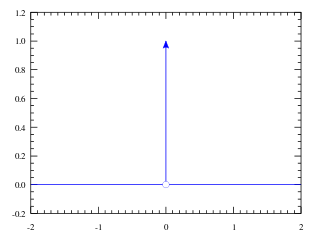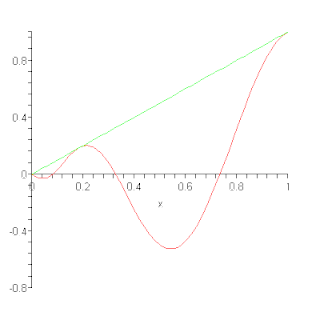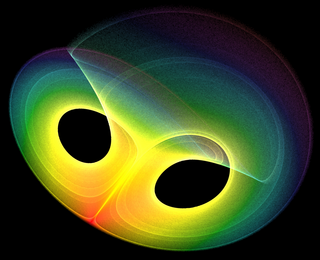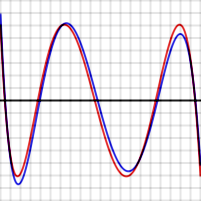
In mathematics, the Dirac delta function is a generalized function or distribution introduced by the physicist Paul Dirac. It is used to model the density of an idealized point mass or point charge as a function equal to zero everywhere except for zero and whose integral over the entire real line is equal to one. As there is no function that has these properties, the computations made by the theoretical physicists appeared to mathematicians as nonsense until the introduction of distributions by Laurent Schwartz to formalize and validate the computations. As a distribution, the Dirac delta function is a linear functional that maps every function to its value at zero. The Kronecker delta function, which is usually defined on a discrete domain and takes values 0 and 1, is a discrete analog of the Dirac delta function.
In mathematics, the Weil conjectures were some highly influential proposals by André Weil (1949), which led to a successful multi-decade program to prove them, in which many leading researchers developed the framework of modern algebraic geometry and number theory.

In the mathematical field of numerical analysis, a Bernstein polynomial, named after Sergei Natanovich Bernstein, is a polynomial in the Bernstein form, that is a linear combination of Bernstein basis polynomials.

Sergei Natanovich Bernstein was a Russian and Soviet mathematician of Jewish origin known for contributions to partial differential equations, differential geometry, probability theory, and approximation theory.
In mathematics, a sequence {s1, s2, s3, ...} of real numbers is said to be equidistributed, or uniformly distributed, if the proportion of terms falling in a subinterval is proportional to the length of that interval. Such sequences are studied in Diophantine approximation theory and have applications to Monte Carlo integration.
In mathematical analysis, Bernstein's inequality is named after Sergei Natanovich Bernstein. The inequality states that on the complex plane, within the disk of radius 1, the degree of a polynomial times the maximum value of a polynomial is an upper bound for the similar maximum of its derivative.
The Remez algorithm or Remez exchange algorithm, published by Evgeny Yakovlevich Remez in 1934, is an iterative algorithm used to find simple approximations to functions, specifically, approximations by functions in a Chebyshev space that are the best in the uniform norm L∞ sense.
In mathematics, the Riesz potential is a potential named after its discoverer, the Hungarian mathematician Marcel Riesz. In a sense, the Riesz potential defines an inverse for a power of the Laplace operator on Euclidean space. They generalize to several variables the Riemann–Liouville integrals of one variable.
In mathematics, the Markov brothers' inequality is an inequality proved in the 1890s by brothers Andrey Markov and Vladimir Markov, two Russian mathematicians. This inequality bounds the maximum of the derivatives of a polynomial on an interval in terms of the maximum of the polynomial. For k = 1 it was proved by Andrey Markov, and for k = 2,3,... by his brother Vladimir Markov.
In mathematics, the ATS theorem is the theorem on the approximation of a trigonometric sum by a shorter one. The application of the ATS theorem in certain problems of mathematical and theoretical physics can be very helpful.
In mathematics, a submodular set function is a set function whose value, informally, has the property that the difference in the incremental value of the function that a single element makes when added to an input set decreases as the size of the input set increases. Submodular functions have a natural diminishing returns property which makes them suitable for many applications, including approximation algorithms, game theory and electrical networks. Recently, submodular functions have also found immense utility in several real world problems in machine learning and artificial intelligence, including automatic summarization, multi-document summarization, feature selection, active learning, sensor placement, image collection summarization and many other domains.
Nikolai Maximovich Günther was a Russian mathematician known for his work in potential theory and in integral and partial differential equations: later studies have uncovered his contributions to the theory of Gröbner bases.
In mathematics, moduli of smoothness are used to quantitatively measure smoothness of functions. Moduli of smoothness generalise modulus of continuity and are used in approximation theory and numerical analysis to estimate errors of approximation by polynomials and splines.

Naum Ilyich Akhiezer was a Soviet mathematician of Jewish origin, known for his works in approximation theory and the theory of differential and integral operators. He is also known as the author of classical books on various subjects in analysis, and for his work on the history of mathematics. He is the brother of the theoretical physicist Aleksander Akhiezer.
Isidor Pavlovich Natanson was a Swiss-born Soviet mathematician known for contributions to real analysis and constructive function theory, in particular, for his textbooks on these subjects. His son, Garal'd Natanson (1930–2003), was also a known mathematician.
Mathematical Reviews is a journal published by the American Mathematical Society (AMS) that contains brief synopses, and in some cases evaluations, of many articles in mathematics, statistics, and theoretical computer science. The AMS also publishes an associated online bibliographic database called MathSciNet which contains an electronic version of Mathematical Reviews and additionally contains citation information for over 3.5 million items as of 2018.







